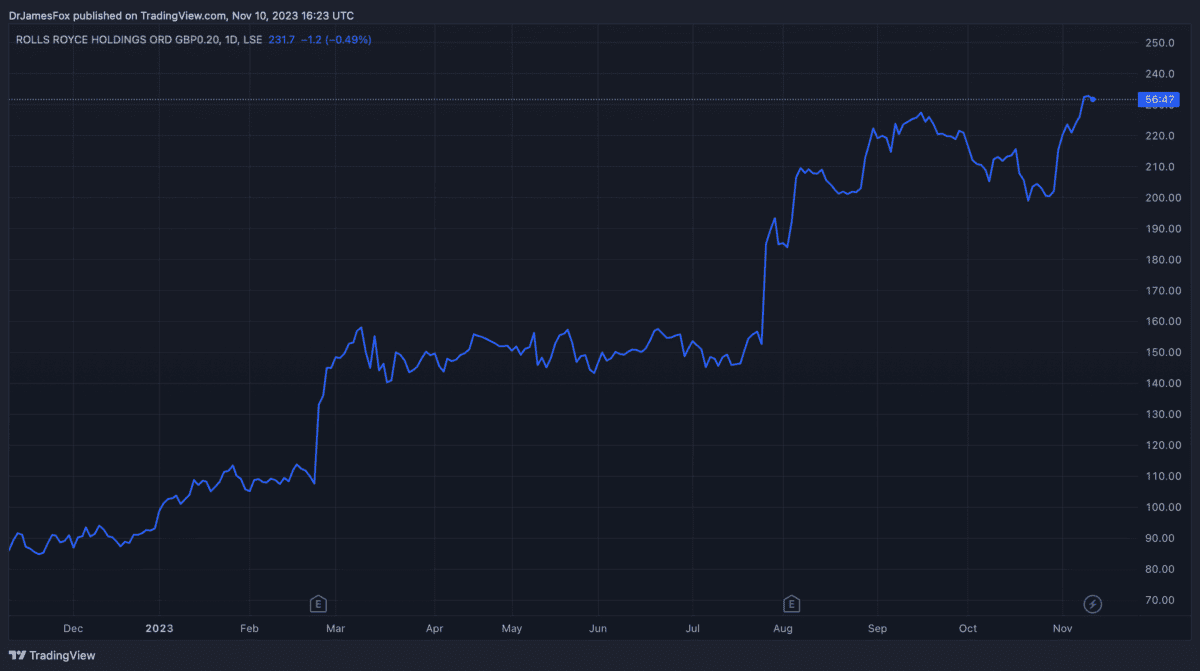FTSE 100 stocks have largely underperformed over the past five years. The index is up just 5.7% over the period, while the Nasdaq exchange has surged more than 100%.
But one stock that has outperformed over the past 12 months is Rolls-Royce. It was hugely under-appreciated until late 2022 when the stock started to push upwards.
So, which companies could be next? Let’s take a closer look.
Woefully mispriced
When Morgan Stanley said Rolls-Royce was woefully mispriced, it meant that the company’s stock was trading at a price that was significantly below its intrinsic value.
This could be due to a number of factors, such as investor pessimism about the company’s prospects, or a lack of understanding of its underlying strengths.
Morgan Stanley analysts believed that Rolls-Royce was undervalued because it’s well-positioned to benefit from the recovery in the global aviation industry.
The company has a leading position in the manufacture of aircraft engines, and it’s also a major provider of maintenance, repair, and overhaul (MRO) services.
Morgan Stanley estimated that Rolls-Royce’s earnings could recover to pre-pandemic levels by 2024, and that its cash flow could improve even more quickly.
It looks like it was right. It’s among the best performing FTSE 100 stocks.

Valuations
To assess whether companies are undervalued, we need to look at valuation metrics. These can be combined with our own knowledge of the sectors in which they operate or the businesses themselves.
So, let’s have a closer look at a handful of FTSE 100 stocks that could be regarded as undervalued.
| Aviva | Barclays | Burberry | Hargreaves Lansdown | Hikma | IAG | Lloyds | Smith & Nephew | |
| P/E Forward | 13.6 | 6.1 | 14.2 | 12 | 14 | 4 | 5.8 | 23.9 |
| P/E FY2025 | 8.9 | 3.5 | 11.9 | 11.7 | 10 | 4.3 | 5.1 | 15.9 |
| P/S | 0.7 | 0.9 | 1.9 | 4.5 | 1.8 | 0.3 | 1.4 | 2 |
| PEG Forward | N.A. | 1.2 | 1.4 | 11 | 1.2 | 4.5 | 0.5 | 1.4 |
| P/B | 1.2 | 0.4 | 4.1 | 4.6 | 2.1 | 4.3 | 0.6 | 2 |
| Price-to-Cash Flow | 1.22 | N.A. | 8.1 | 15.2 | 8.1 | 1.5 | 1 | 28.4 |
Assessing the data
Now, clearly there’s a weakness to the above data set. And that’s because these are companies from different sectors.
However, with some background knowledge, we can come to some conclusions that can help us make informed investment decisions.
For example, we know that Barclays’ and Lloyds’ price-to-earnings ratios are below the industry average. These two banks also trade at a considerable discount versus their net asset value.
We also know that companies with PEG ratios near or below one are often undervalued. In the above data, the PEG ratios of Barclays, Burberry, Hikma, Lloyds, and Smith & Nephew all catch my eye.
So, what conclusions can I take draw, and might any of these stocks surge like Rolls?
Barclays and Lloyds both have very attractive metrics. However, investors are still wary about the concerning threat of mass defaults. Personally, I believe the risks are overplayed and the stocks could both jump.
Hikma and Smith & Nephew have interesting PEG metrics. These companies are expected to grow quickly in the coming years, and that growth might not be thoroughly priced in.
Luxury stocks normally trade at a premium, but Burberry is starting to look quite cheap with a PEG ratio of 1.4. However, improving Chinese consumption will be key to any growth.








